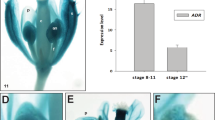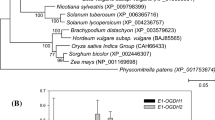Abstract
Plant mitochondria include gamma-type carbonic anhydrases (γCAs) of unknown function. In Arabidopsis, the γCAs form a gene family of five members which all are attached to the NADH dehydrogenase complex (complex I) of the respiratory chain. Here we report a functional analysis of gamma carbonic anhydrase 2 (CA2). The gene encoding CA2 is constitutively expressed in all plant organs investigated but it is ten fold induced in flowers, particularly in tapetal tissue. Ectopic expression of CA2 in Arabidopsis causes male sterility in transgenic plants. In normal anther development, secondary thickenings of the endothecial cell wall cause anthers to open upon dehydration. Histological analyses revealed that abnormal secondary thickening prevents anther opening in 35S::CA2 transgenic plants. CA2 abundance in transgenic plants is increased 2–3 fold compared to wild-type plants as revealed by Western blotting analyses. Moreover, abundance of other members of the CA family, termed CA3 and CAL2, is increased in transgenic plants. Oxygen uptake measurements revealed that respiration in transgenic plants is mainly based on NADH reduction by the alternative NADH dehydrogenases present in plant mitochondria. Furthermore, the formation of reactive oxygen species (ROS) is very low in transgenic plants. We propose that reduction in ROS inhibits H2O2 dependent lignin polymerization in CA2 over-expressing plants, thereby causing male sterility.









Similar content being viewed by others
References
Alber BE, Ferry JG (1994) A carbonic anhydrase from the archaeon Methanosarcina thermophila. Proc Natl Acad Sci USA 91:6909–6913. doi:10.1073/pnas.91.15.6909
Andrukhiv A, Costa AD, West IC, Garlid KD (2006) Opening mitoKATP increases superoxide generation from complex I of the electron transport chain. Am J Physiol Heart Circ Physiol 291:2067–2074. doi:10.1152/ajpheart.00272.2006
Badger MR, Price GD (1994) The Role of carbonic anhydrase in photosynthesis. Annu Rev Plant Physiol Plant Mol Biol 45:369–392. doi:10.1146/annurev.pp.45.060194.002101
Bartoli CG, Pastori GM, Foyer CH (2000) Ascorbate biosynthesis in mitochondria is linked to the electron transport chain between complexes III and IV. Plant Physiol 123:335–344. doi:10.1104/pp.123.1.335
Bartoli CG, Yu J, Gómez F, Fernández L, McIntosh L, Foyer CH (2006) Inter-relationships between light and respiration in the control of ascorbic acid synthesis and accumulation in Arabidopsis thaliana leaves. J Exp Bot 57:1621–1631. doi:10.1093/jxb/erl005
Bechtold N, Pelletier G (1998) In planta Agrobacterium-mediated transformation of adult Arabidopsis thaliana plants by vacuum infiltration. Methods Mol Biol 82:259–266
Boerjan W, Ralph J, Baucher M (2003) Lignin biosynthesis. Annu Rev Plant Biol 54:519–546. doi:10.1146/annurev.arplant.54.031902.134938
Bonner L, Dickinson H (1989) Anther dehiscence in Lycopersicon esculentum mill. New Phytol 113:97–115. doi:10.1111/j.1469-8137.1989.tb02399.x
Braun HP, Zabaleta E (2007) Carbonic anhydrase subunits of the mitochondrial NADH dehydrogenase complex (complex I) in plants. Physiol Plant 129:114–122. doi:10.1111/j.1399-3054.2006.00773.x
Clough SJ, Bent AF (1998) Floral dip: a simplified method for Agrobacterium-mediated transformation of Arabidopsis thaliana. Plant J 16:735–743. doi:10.1046/j.1365-313x.1998.00343.x
Conklin PL (2001) Recent advances in the role and biosynthesis of ascorbic acid in plants. Plant Cell Environ 24:383–394. doi:10.1046/j.1365-3040.2001.00686.x
Conklin PL, Barth C (2004) Ascorbic acid, a familiar small molecule intertwined in the response of plants to ozone, pathogens, and the onset of senescence. Plant Cell Environ 27:959–971. doi:10.1111/j.1365-3040.2004.01203.x
Dawson J, Wilson ZA, Briarty LG, Mulligan BJ (1993) Development of anthers and pollen in male sterile mutants of Arabidopsis thaliana. In: Bowman J (ed) Arabidopsis: an atlas of morphology. Springer, Berlin, pp 282–295
Dawson J, Sözen E, Vizir I, Van Waeyenberge S, Wilson ZA, Mulligan BJ (1999) Characterization and genetic mapping of a mutation (ms35) which prevents anther dehiscence in Arabidopsis thaliana by affecting secondary wall thickening in the endothecium. New Phytol 144:213–222. doi:10.1046/j.1469-8137.1999.00507.x
Encina A, Fry SC (2005) Oxidative coupling of a feruloyl-arabinoxylan trisaccharide (FAXX) in the walls of living maize cells requires endogenous hydrogen peroxide and is controlled by a low-Mr apoplastic inhibitor. Planta 223:77–89. doi:10.1007/s00425-005-0033-y
Fry SC (2000) The growing plant cell wall: chemical and metabolic analysis, 2nd edn. Blackburn Press, Caldwell
Fry SC (2004) Oxidative coupling of tyrosine and ferulic acid residues, intra- and extra-protoplasmic occurrence, predominance of trimers and larger products, and possible role in inter-polymeric cross-linking. Phytochem Rev 3:97–111. doi:10.1023/B:PHYT.0000047808.74647.43
Goldberg R, Beals T, Sanders P (1993) Anther development: basic principles and practical applications. Plant Cell 5:1217–1229
Gray GR, Maxwell DP, Villarimo AR, McIntosh L (2004) Mitochondria/nuclear signaling of alternative oxidase gene expression occurs through distinct pathways involving organic acids and reactive oxygen species. Plant Cell Rep 23:497–503. doi:10.1007/s00299-004-0848-1
Griffith OW (1980) Determination of glutathione and glutathione disulfide using glutathione reductase and 2-vinylpyridine. Anal Biochem 106:207–212. doi:10.1016/0003-2697(80)90139-6
Hewett-Emmett D (2000) Evolution and distribution of the carbonic anhydrase gene families. EXS 2000:29–76
Kärkönen A, Fry SC (2006) Effect of ascorbate and its oxidation products on H2O2 production in cell-suspension cultures of Picea abies and in the absence of cells. J Exp Bot 57:1633–1644. doi:10.1093/jxb/erj197
Karlsson M, Melzer M, Prokhorenko I, Johansson T, Wingsle G (2005) Hydrogen peroxide and expression of hipI-superoxide dismutase are associated with the development of secondary cell walls in Zinnia elegans. J Exp Bot 56:2085–2093. doi:10.1093/jxb/eri207
Kawasaki T, Koita H, Nakatsubo T, Hasegawa K, Wakabayashi K, Takahashi H, Umemura K, Umezawa T, Shimamoto K (2006) Cinnamoyl-CoA reductase, a key enzyme in lignin biosynthesis, is an effector of small GTPase Rac in defense signaling in rice. Proc Natl Acad Sci USA 103:230–235. doi:10.1073/pnas.0509875103
Keijzer C (1987) The processes of anther dehiscence and pollen dispersal. I. The opening mechanism of longitudinally dehiscing anthers. New Phytol 105:487–489. doi:10.1111/j.1469-8137.1987.tb00886.x
Kerr EM, Fry SC (2004) Extracellular cross-linking of xylan and xyloglucan in maize cell-suspension cultures: the role of oxidative phenolic coupling. Planta 219:73–83. doi:10.1007/s00425-004-1210-0
Lee SB, Bae IH, Bae YS, Um HD (2006) Link between mitochondria and NADPH oxidase 1 isozyme for the sustained production of reactive oxygen species and cell death. J Biol Chem 281:36228–36235. doi:10.1074/jbc.M606702200
Meyerowitz E (1987) In situ hybridization to RNA in plant tissue. Plant Mol Biol Rep 5:242–250. doi:10.1007/BF02669719
Millar AH, Mittova V, Kiddle G, Heazlewood JL, Bartoli CG, Theodoulou FL, Foyer CH (2003) Control of ascorbate synthesis by respiration and its implications for stress responses. Plant Physiol 133:443–447. doi:10.1104/pp.103.028399
Miwa S, Brand MD (2003) Mitochondrial matrix reactive oxygen species production is very sensitive to mild uncoupling. Biochem Soc Trans 6:1300–1301. doi:10.1042/BST0311300
Møller IM, Jensen PE, Hansson A (2007) Oxidative modifications to cellular components in plants. Annu Rev Plant Biol 58:459–481. doi:10.1146/annurev.arplant.58.032806.103946
Neuhoff V, Stamm R, Pardowitz I, Arold N, Ehrhardt W, Taube D (1990) Essential problems in quantification of proteins following colloidal staining with coomassie brilliant blue dyes in polyacrylamide gels, and their solution. Electrophoresis 11:101–117. doi:10.1002/elps.1150110202
Otter T, Polle A (1994) The influence of apoplastic ascorbate on the activities of cell wall-associated peroxidase and NADH oxidase in needles of Norway spruce (Picea abies L.). Plant Cell Physiol 35:1231–1238
Parisi G, Perales M, Fornasari MS, Colaneri A, González-Schain N, Gómez-Casati D, Zimmermann S, Brennicke A, Araya A, Ferry JG, Echave J, Zabaleta E (2004) Gamma carbonic anhydrases in plant mitochondria. Plant Mol Biol 55:193–207. doi:10.1007/s11103-004-0149-7
Pedreira J, Sanz N, Pena MJ, Sánchez M, Queijeiro E, Revilla G, Zarra I (2004) Role of apoplastic ascorbate and hydrogen peroxide in the control of cell growth in pine hypocotyls. Plant Cell Physiol 45:530–534. doi:10.1093/pcp/pch059
Perales M, Parisi G, Fornasari MS, Colaneri A, Villarreal F, González-Schain N, Echave J, Gómez-Casati D, Braun HP, Araya A, Zabaleta E (2004) Gamma carbonic anhydrase like complex interact with plant mitochondrial complex I. Plant Mol Biol 56:947–957. doi:10.1007/s11103-004-6324-z
Perales M, Eubel H, Heinemeyer J, Colaneri A, Zabaleta E, Braun HP (2005) Disruption of a nuclear gene encoding a mitochondrial gamma carbonic anhydrase reduces complex I and supercomplex I + III2 levels and alters mitochondrial physiology in Arabidopsis. J Mol Biol 350:263–277. doi:10.1016/j.jmb.2005.04.062
Peters K, Dudkina NV, Jänsch L, Braun HP, Boekema EJ (2008) A structural investigation of complex I and I + III2 supercomplex from Zea mays at 11–13 A resolution: assignment of the carbonic anhydrase domain and evidence for structural heterogeneity within complex I. Biochim Biophys Acta 1777:84–93. doi:10.1016/j.bbabio.2007.10.012
Räisänen SR, Lehenkari P, Tasanen M, Rahkila P, Härkönen PL, Väänänen HK (1999) Carbonic anhydrase III protects cells from hydrogen peroxide-induced apoptosis. FASEB J 13:513–522
Ralph J, Lundquist K, Brunow G et al (2004) Lignins: natural polymers from oxidative coupling of 4-hydroxyphenylpropanoids. Phytochem Rev 3:29–60. doi:10.1023/B:PHYT.0000047809.65444.a4
Ren D, Yang H, Zhang S (2002) Cell death mediated by MAPK is associated with hydrogen peroxide production in Arabidopsis. J Biol Chem 277:559–565
Ruzin SE (1999) Plant microtechnique and microscopy. Oxford University Press, Oxford, NY, p 323
Sambrook J, Russell D (2001) Molecular cloning, a laboratory manual, 3rd edn. Cold Spring Harbor Laboratory Press, Cold Spring Harbor
Sánchez M, Quiejeiro E, Revilla G, Zarra I (1997) Changes in ascorbic acid levels in apoplastic fluid during growth of pine hypocotyls. Effect on peroxidase activities associated with cell walls. Physiol Plant 101:815–820. doi:10.1111/j.1399-3054.1997.tb01068.x
Schägger H, von Jagow G (1987) Tricine-sodium dodecyl sulfate-polyacrylamide gel electrophoresis for the separation of proteins in the range from 1 to 100 kDa. Anal Biochem 166:368–379. doi:10.1016/0003-2697(87)90587-2
Smith KS, Jakubzick C, Whittam TS, Ferry JG (1999) Carbonic anhydrase is an ancient enzyme widespread in prokaryotes. Proc Natl Acad Sci USA 96:15184–15189. doi:10.1073/pnas.96.26.15184
Sunderhaus S, Dudkina NV, Jänsch L, Klodmann J, Heinemeyer J, Perales M, Zabaleta E, Boekema EJ, Braun HP (2006) Carbonic anhydrase subunits form a matrix-exposed domain attached to the membrane arm of mitochondrial complex I in plants. J Biol Chem 281:6482–6488. doi:10.1074/jbc.M511542200
Takahama U (1993a) Redox state of ascorbic acid in the apoplast of stems of Kalanchoë daigremontiana. Physiol Plant 89:791–798. doi:10.1111/j.1399-3054.1993.tb05286.x
Takahama U (1993b) Regulation of peroxidase-dependent oxidation of phenolics by ascorbic acid: different effects of ascorbic acid on the oxidation of coniferyl alcohol by the apoplastic soluble and cell wall-bound peroxidases from epicotyls of Vigna angularis. Plant Cell Physiol 34:809–817
Torres MA, Dangl JL (2005) Functions of the respiratory burst oxidase in biotic interactions, abiotic stress and development. Curr Opin Plant Biol 8:397–403. doi:10.1016/j.pbi.2005.05.014
Yang C, Xu Z, Song J, Conner K, Barrena VG, Wilson ZA (2007) Arabidopsis MYB26/MALE STERILE35 regulates secondary thickening in the endothecium and is essential for Anther Dehiscence. Plant Cell 19:534–548. doi:10.1105/tpc.106.046391
Zabaleta E, Heiser V, Grohmann L, Brennicke A (1998) Promoters of nuclear-encoded respiratory chain complex I genes from Arabidopsis thaliana contain a region essential for anther/pollen-specific expression. Plant J 15:49–59. doi:10.1046/j.1365-313X.1998.00177.x
Zimmerman SA, Ferry JG (2008) The beta and gamma classes of carbonic anhydrase. Curr Pharm Des 14:716–721. doi:10.2174/138161208783877929
Zimmerman U, Wang P, Zhang X, Bogdanovich S, Forster R (2004) Anti-oxidative response of carbonic anhydrase III in skeletal muscle. IUBMB Life 56:343–347. doi:10.1080/1521-6540400000850
Acknowledgments
This work was supported in part by ANPCyT (13432 and 31669) (Argentina), DAAD (Germany), ECOS-Sud, (A06B03) (France-Argentina). FV and MVM (CONICET, Argentina) are doctoral fellows and this work is part of their doctoral theses.
Author information
Authors and Affiliations
Corresponding author
Additional information
Gene bank accession number: AY085025 (At1g47260).
Rights and permissions
About this article
Cite this article
Villarreal, F., Martín, V., Colaneri, A. et al. Ectopic expression of mitochondrial gamma carbonic anhydrase 2 causes male sterility by anther indehiscence. Plant Mol Biol 70, 471–485 (2009). https://doi.org/10.1007/s11103-009-9484-z
Received:
Accepted:
Published:
Issue Date:
DOI: https://doi.org/10.1007/s11103-009-9484-z




